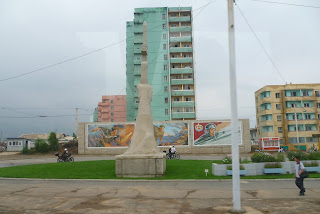The Great Leaders
Coming from a city that is perpetually surrounded by advertising, it was odd to see that the only type of advertising that goes on in North Korea are propaganda billboards. The pictures and paintings of Kim Jong Il-the DPRK’s Supreme Leader from 1994 to 2001 and his father, the Dear Leader Kim Il Sun, can be found everywhere. Even the billboards without them would have paintings of patriotic soldiers motivating citizens to defend their country and remind them of the importance of self-sustenance. Juche is the political ideology of North Korea which means self-reliance authoritarian rule. There’s even a Tower of the Juche idea built, with an eternal fire at the top of the tower. The idea is for North Korea to have political independence, economic self-sustenance and self-reliance in defence. These ideas are widespread and constantly drilled into everyone’s minds, not only on billboards, but also on television, where the local channel always airs concerts of war songs, and music videos with images of the atrocities of the war times and of course in newspapers.
The Mansu Hill Grand Monument has magnificent bronze statutes of the leaders. Our two tour leaders (yes every group has two leaders-one does the talking and the other checks on the other and keeps an eye on the group so always follows last in the group) made sure we bought flowers and lined up single file and bowed to the monument solemnly to show respect. For North Koreans, their leaders are still alive in their hearts, so we only bow once (instead of three times, when the person has died). Every North Korean’s essential dress code includes a pin of their great leaders. A new edition of the pin comes out each year, so we’ve seen different versions of them. They’re not for sale though. If someone’s pin gets lost, an application needs to be made for a new one to be issued. W came across hundreds of students in the Kim Il Sung Square during the day and evening practicing for the mass celebrations in October to celebrate the founding of the Workers’ Party of Korea’s 70th anniversary. There’s also the Airirang Mass Games that mobilizes tens of thousands of people to participate, but they’ve been cancelled for the past two years. It takes months and months to organize but people that participate get gifts from the government, like television sets, and packs of food, so many choose to participate in the fun.
The International Friendship Exhibition is a 200,000 square feet museum housing the tens of thousands of gifts that have been given to North Korea’s leaders in Myohyangsan, a two hour drive from Pyongyang. It was pouring rain that day and flooding in many places, but the potholes on the road were the most annoying part. Unfortunately, no pictures were allowed. We had wear shoe covers before entering the larger than life building that is typical of North Korea’s Stalinist architecture and had to bow when we came across the wax statutes of the leaders. The idea of the museum is to show North Koreans and tourists that the country is so wonderful that the leaders receive gifts from all over the world. According to unofficial sources, even during the famine years in the 1990s, North Korea still provided aid to Middle Eastern and African countries to build up more allies, so it’s not surprising to see gifts from countries like Libya. Gifts range from tiger and bear heads to a dining table and even a room dedicated to a bullet proof car and aeroplane from the Russians. Smaller gifts range from chess sets and pens to suitcases and books-you name it and the museum probably has it!











No comments:
Post a Comment